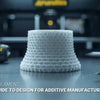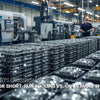How Can You Achieve Perfect Surface Finishes in Internal Sharp Corners and Deep Recesses?

How Can You Achieve Perfect Surface Finishes in Internal Sharp Corners and Deep Recesses?

If you've ever struggled with poor plating coverage in tight cavities or noticed thin, flaky coatings on internal features, you're not alone. Manufacturing engineers and product designers face this challenge daily when working with complex parts. The problem becomes even more frustrating when external surfaces look perfect while internal sharp corner surface finish remains inadequate. Understanding why this happens and knowing the proven solutions can save you thousands in rejected parts and rework costs.
Quick Answer: Your Immediate Solutions
Key Takeaways - Your Quick Solutions:
- The Root Cause: Faraday Cage Effect blocks current and coating materials from reaching internal corners effectively
- Quick Fix #1: Add a 0.5-1.0mm radius to sharp internal corners during the design phase
- Quick Fix #2: Switch to pulse plating instead of standard DC electroplating for better distribution
- Quick Fix #3: Use electroless nickel plating for complex shapes (no electricity means no Faraday effect)
- Quick Fix #4: Apply extended nozzles (SNP) for spray coating deep cavities and hard-to-reach areas
- Best Practice: Combine design changes with process adjustments for guaranteed, consistent results
Now that you know the quick fixes, let's dive deeper into understanding each solution. By learning the science behind these coating failures, you'll be able to prevent problems before they start. Moreover, you'll know exactly which technique works best for your specific part geometry and production requirements.
Table of Contents
- Why Do Internal Sharp Corners Show Poor Plating Coverage and Weak Adhesion?
- What Is Pulse Plating and How Does It Help With Deep Recess Coverage?
- Can You Improve Coating Without Redesigning the Part?
- How Much Radius Do You Actually Need for Uniform Coating Thickness?
- Conclusion
Why Do Internal Sharp Corners Show Poor Plating Coverage and Weak Adhesion?
The Hidden Physics Problem
When parts come back from the plating shop with perfect external surfaces but disappointing internal features, there's a specific scientific reason. This isn't about poor workmanship or bad luck. Instead, it's about fundamental physics working against you. The Faraday cage effect plating creates an invisible barrier that prevents proper coating deposition in recessed areas.
The Problem in Simple Terms
Here's what happens during electroplating:
- Electrical current naturally follows the path of least resistance through the plating solution
- External corners and raised features receive concentrated current flow
- Sharp internal angles and deep recesses get "shadowed" or blocked from current
- Result: Thin, porous plating or complete lack of deposition in problem areas
- The sharper your corner angle, the more severe this coverage failure becomes
Understanding the Science Behind Coverage Failure
The physics gets interesting when you look closely at what happens at the molecular level. During electroplating, positively charged metal ions travel through the solution toward the negatively charged part (cathode). However, electrical field lines concentrate at external corners and edges because of their geometry. This creates "high current density zones" on outside features.
Meanwhile, internal corners create the opposite effect. The electrical field lines spread apart and weaken as they try to penetrate into recesses. Think of it like trying to shine a flashlight into a deep, narrow hole—the light gets dimmer the deeper you go. Similarly, current density drops dramatically in internal features, starving these areas of the metal ions needed for proper plating.
Furthermore, as plating builds up on external surfaces, it actually makes the problem worse. The growing deposit on high points acts like a shield, further blocking current from reaching internal corners. This creates a self-reinforcing cycle where good areas get better while problem areas get worse. Consequently, you end up with extremely uneven coating thickness across the part.
What Is Pulse Plating and How Does It Help With Deep Recess Coverage?
The Technology That Changes Everything
Traditional DC (direct current) electroplating runs continuously, which causes the ion depletion problem we just discussed. However, pulse electroplating uniformity offers a smarter approach. By cycling the current on and off in precise patterns, this technique gives metal ions time to redistribute throughout the solution, including into those problematic deep areas.
How Pulse Plating Works Step-by-Step
The pulse cycle has two critical phases:
- On-time (Peak Current): High current bursts deposit metal rapidly on all exposed surfaces
- Off-time (Zero Current): Metal ions diffuse naturally back into depleted recesses and corners
- Pulse Reverse (Advanced): Brief current reversal gently removes excess buildup from high points
- Net Result: Significantly improved plating deep recesses coverage compared to standard DC methods
The Science of Better Distribution
During the off-time period, something remarkable happens in the plating solution. Without electrical current driving reactions, concentration gradients naturally level out through diffusion. Metal ions that were depleted from internal corners during the on-time slowly migrate back into these areas. This happens because nature always tries to balance concentration differences.
Additionally, pulse reverse plating takes this concept further. By briefly reversing the current, you create a gentle etching effect that preferentially removes metal from high-current-density areas (the external corners). This excess metal then dissolves back into the solution as ions, which subsequently become available to deposit in the low-current-density areas during the next forward pulse.
The key to success lies in optimizing three parameters: pulse frequency, duty cycle, and peak current. Generally, frequencies between 10 and 1000 Hz work well, with duty cycles (on-time percentage) ranging from 10% to 50%. Lower duty cycles give more off-time for diffusion, which helps when dealing with extremely deep recesses or complex industrial machinery components.
Can You Improve Coating Without Redesigning the Part?
When Design Changes Aren't an Option
Sometimes you're stuck with the part geometry you have. Perhaps the design is already in production, or maybe the sharp corners serve a critical functional purpose. Therefore, you need process-based solutions rather than design modifications. The good news is that several proven techniques can dramatically improve coating internal corners without touching the CAD file.
Process Adjustments for Electroplating
Try these modifications to your plating process:
Solution Agitation Techniques:
- Increase agitation speed by 50-100% to reduce boundary layer thickness
- Use air sparging to create turbulent flow patterns near recessed features
- Install rotating cathode fixtures that constantly change part orientation relative to anodes
Strategic Anode Placement:
- Add auxiliary anodes positioned to direct current flow into problematic cavities
- Use conforming anodes that match the part's internal geometry when possible
- Shield primary anodes from high-current external areas using non-conductive barriers
Chemistry Adjustments:
- Select brightener additives specifically formulated for low-current-density performance
- Increase metal ion concentration to minimize depletion effects in recesses
- Adjust pH and temperature to improve throwing power of the plating solution

Process Adjustments for Spray Coating
When dealing with powder coating deep channels or wet paint application, mechanical access becomes the primary challenge. Extended nozzles (sometimes called SNP - Special Nozzle Pattern) allow you to physically reach into cavities that standard spray guns cannot access. These specialized tools feature narrow, rigid extensions that maintain proper spray pattern even 6-12 inches from the gun body.
Moreover, reducing fluid pressure helps with wrap-around coverage. While this seems counterintuitive, lower pressure creates a softer spray pattern with less bounce-back. The coating particles move more slowly, giving them time to change direction and coat surfaces that aren't in direct line-of-sight. However, you'll need to make multiple passes from different angles to ensure complete coverage.
For powder coating specifically, manipulating the electrostatic charge can improve penetration into recesses. Reducing voltage slightly decreases the initial attraction force, allowing particles to float deeper into cavities before adhering. Additionally, using smaller particle sizes (generally 20-30 microns instead of standard 40-60 microns) helps powder navigate tight spaces more effectively.
How Much Radius Do You Actually Need for Uniform Coating Thickness?
The Single Most Powerful Design Change
If you can modify the part design, adding radii to internal corners delivers more improvement than any process adjustment alone. This approach directly addresses the root cause by eliminating the sharp geometric features that create current concentration and coating flow problems. Even small radii make a significant difference in achieving consistent surface finishing complex geometries.
Practical Radius Guidelines
Here's what the data shows about radius design for coating effectiveness:
- Minimum Improvement Threshold: 0.5mm (0.020 inches) radius provides noticeable coverage enhancement
- Recommended Standard: 1.0mm (0.040 inches) radius delivers reliable, robust results for most applications
- Heavy-Duty Applications: 2.0mm (0.080 inches) or larger for parts requiring thick coatings or severe service conditions
- Why It Works: Curved surfaces allow gradual current density transitions and smooth material flow paths
Engineering the Right Radius for Your Application
Selecting the appropriate radius involves balancing three competing factors: coating performance, part function, and manufacturing cost. Larger radii always improve coating uniformity, but they might interfere with how the part fits with mating components. Additionally, adding radii can increase machining time and tool wear, especially on die casting or CNC-machined parts.
Start by calculating the minimum bend radius that your coating process can handle effectively. For electroplating, a good rule of thumb states that the radius should be at least 1.5 times your target coating thickness. Therefore, if you need 25 microns of plating, aim for a minimum 0.04mm radius. This ensures the electrical field strength remains sufficient for proper deposition.
Furthermore, consider the entire manufacturing process chain. Sharp internal corners often create problems beyond just coating—they're also stress concentration points that can lead to crack initiation. By adding radii for coating purposes, you simultaneously improve the part's mechanical durability. This dual benefit often justifies the added manufacturing cost.
Document your radius requirements clearly on engineering drawings using standard callouts like "R1.0mm ALL INTERNAL CORNERS" or "BREAK ALL SHARP EDGES 0.5mm RADIUS." Be specific about which features need radii, as removing all sharp edges sometimes isn't possible due to functional requirements. Communication between design, manufacturing, and finishing teams prevents expensive surprises during production.
Conclusion
Achieving perfect finishes on internal sharp corners and deep recesses doesn't require magic—it requires understanding the physics and applying proven solutions systematically. Remember that the Faraday Cage Effect is your primary enemy, blocking current and coating materials from reaching problematic areas. However, armed with the right knowledge, you can overcome this challenge through smart design choices and process optimization.
The most effective approach combines multiple strategies rather than relying on a single fix. Start by adding radii to internal corners during the design phase whenever functionally possible—this single change delivers more improvement than any other modification. Next, select the appropriate finishing technology for your geometry: consider electroless nickel for complex shapes, pulse plating for moderate recesses, or specialized spray techniques with extended nozzles for coating applications.
When design changes aren't feasible, process adjustments can still achieve acceptable results. Increase solution agitation, add auxiliary anodes strategically, and use chemistry formulated for low-current-density areas. For spray coating, invest in extended nozzles and optimize your application technique with multiple angles and reduced pressure. Finally, test and validate your chosen approach with sample parts before committing to full production. Measure coating thickness at multiple points, especially in those challenging internal features, to confirm uniform coverage.
By following these guidelines and understanding the underlying principles, you'll consistently achieve the uniform, high-quality finishes your parts require—even in the most challenging internal geometries.
External Links & Further Reading
[Plating deep recesses coverage][^1]
[Pulse electroplating uniformity][^2]
[Internal sharp corner surface finish][^3]
[Surface finishing complex geometries][^4]
[Faraday cage effect plating][^5]
[Radius design for coating][^6]
---
[^1]: Explore this link to discover advanced techniques that enhance plating in deep recesses, ensuring uniform coverage and quality.
[^2]: Learn about pulse electroplating's benefits for achieving uniformity, which can significantly enhance the quality of your plating projects.
[^3]: Explore this link to discover advanced techniques and tips for achieving high-quality internal sharp corner surface finishes.
[^4]: This resource provides insights and methods for tackling the challenges of surface finishing on complex geometries.
[^5]: Understanding the Faraday cage effect plating can enhance your knowledge of electromagnetic shielding and its applications.
[^6]: Exploring radius design for coating can provide insights into optimizing material usage and improving product durability.





